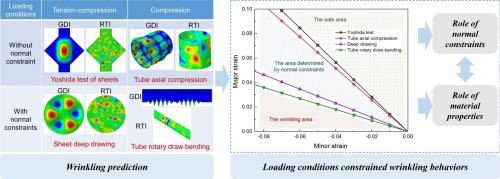Journal of Materials Processing Technology ( IF 6.3 ) Pub Date : 2021-05-01 , DOI: 10.1016/j.jmatprotec.2021.117199 Heng Li , Hong Sun , Haoran Liu , Nan Liu

|
With the increasing usages of high strength and lightweight materials, how to accurately predict and fully understand the wrinkling instability of thin-walled parts forming under various loading conditions, viz. stress states and normal constraints, is still a challenge for free-defect design and manufacturing. In this study, taking tension-compression stress state w/wo normal constraints (Yoshida test and deep drawing of sheets) and compression stress state w/wo normal constraints (axial compression and rotary draw bending of tubes) as the comparative cases, two kinds of geometric imperfections (GI), viz., random thickness imperfection (RTI) and geometric deflection imperfection (GDI) are introuduced and implemented into dynamic explicit finite element (FE) models to realize more sensitive prediction of the wrinkling instability. And then, a systematic comparative study on the critical wrinkling behavior and final wrinkling morphology under varous loading conditions has been studied. It is found that the wrinkling is more prone to occur under tension-compression stress state, and the wrinkling of the processes without normal constraint are severer than those with normal constraints. Furthermore, the effects of material parameters on the wrinkling are inconsistent in different processes, the reason proved to be the different loading conditions. When the degree of normal constraint increases, the influence of material properties becomes negligible. Combining the geometric and material parameters, the key issues affecting the wrinkling of thin-walled parts from the perspective of loading condition have been expounded, laying the foundation and theoretical guidance for the study of wrinkling behavior under different mechanical states.
中文翻译:

载荷条件限制了薄壁板/管零件在金属成形过程中的起皱行为
随着高强度和轻质材料的使用不断增加,如何准确预测和充分理解在各种载荷条件下形成的薄壁零件的起皱不稳定性。应力状态和正常约束仍然是无缺陷设计和制造的挑战。在本研究中,以无正向约束的拉压应力状态(吉田试验和板的深冲)和无正向约束的压应力状态(管的轴向压缩和旋转拉伸弯曲)为比较例,两种引入了几何缺陷(GI),即随机厚度缺陷(RTI)和几何挠度缺陷(GDI)并将其实现为动态显式有限元(FE)模型,以实现对起皱不稳定性的更灵敏的预测。然后,对各种载荷条件下的临界起皱行为和最终起皱形态进行了系统的比较研究。研究发现,在拉压应力状态下,起皱更容易发生,没有正常约束的过程的起皱比有正常约束的过程更严重。此外,材料参数对起皱的影响在不同的过程中是不一致的,原因被证明是不同的加载条件。当法向约束度增加时,材料特性的影响就可以忽略不计。结合几何和材料参数,从载荷条件的角度阐述了影响薄壁零件起皱的关键问题,


























 京公网安备 11010802027423号
京公网安备 11010802027423号